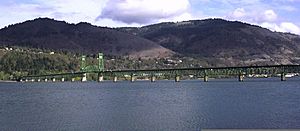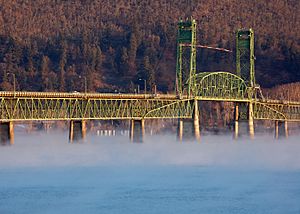Hood River Bridge facts for kids
The Hood River Bridge is a special kind of bridge called a truss bridge. It also has a part that can lift up, making it a vertical lift bridge. This bridge crosses the big Columbia River, connecting Hood River, Oregon and White Salmon, Washington. It helps cars get from I-84 and US-30 in Oregon to Washington State Route 14 in Washington.
Quick facts for kids Hood River Bridge |
|
|---|---|
 |
|
| Coordinates | 45°43′05″N 121°29′43″W / 45.717976°N 121.495211°W |
| Carries | Vehicles |
| Crosses | Columbia River |
| Locale | Between Hood River, Hood River County, Oregon, United States and White Salmon, Klickitat County, Washington, USA |
| Official name | White Salmon Bridge |
| Other name(s) | Hood River Bridge |
| Maintained by | Port of Hood River |
| Characteristics | |
| Design | Through-truss with a vertical lift |
| Total length | 1,346.67 metres (4,418.2 ft) |
| Longest span | 79.92 metres (262.2 ft) |
| History | |
| Opened | December 9, 1924 |
| Statistics | |
| Daily traffic | 4 million (annual) |
| Toll | Cars, vans, pickup without trailer: $2.00, Motorcycles: $1.00. $1.00 toll for each additional trailer axle. |
Contents
History of the Hood River Bridge
The Hood River Bridge is one of the oldest road bridges crossing the Columbia River. It was built by a company called the Oregon-Washington Bridge Company. The bridge first opened to traffic on December 9, 1924. Its original name was the Waucoma Interstate Bridge.
In 1938, the bridge had to be changed. This was because the Bonneville Dam was built about 23 miles (37 km) downstream. The dam caused the river levels to rise, so parts of the bridge needed to be adjusted.
Later, on December 12, 1950, the Port of Hood River bought the bridge. They paid $800,000 for it.
How the Bridge Works
The Hood River Bridge is a toll bridge. This means you have to pay a small fee to cross it. The Port of Hood River manages the bridge and collects these tolls.
Tolls and Rules
Currently, it costs $2.00 for a regular car to cross. Motorcycles pay $1.00. If you have a trailer, you pay an extra $1.00 for each additional axle on the trailer. It's important to know that bicycles and people walking are not allowed to cross this bridge.
Bridge Structure and Size
The bridge is supported by 20 piers, which are like strong columns. Its total length is about 4,418 feet (1,347 meters).
The Hood River Bridge is a special type called a vertical lift bridge. This means a section of the bridge can move up and down.
- When the bridge is closed, there is 67 feet (20 meters) of space under it for boats.
- When the bridge opens, this space increases to 148 feet (45 meters). This usually happens once or twice a month for taller boats.
- The part of the bridge that lifts up is 246 feet (75 meters) wide.
Weight and Height Limits
To keep everyone safe, the bridge has rules about how heavy vehicles can be.
- The total weight limit for a vehicle is 80,000 pounds.
- Each single axle on a vehicle can't weigh more than 20,000 pounds.
- For two axles close together (tandem axles), the limit is 34,000 pounds.
- Also, vehicles taller than 14 feet 7 inches (4.45 meters) are not allowed to cross.
Location on the Columbia River
The Hood River Bridge is located at river mile 169 on the Columbia River. This means it's 169 miles from the mouth of the river. It sits between two other important bridges:
- The Bridge of the Gods, which is at river mile 148.
- The Dalles Bridge, which is at river mile 191.


